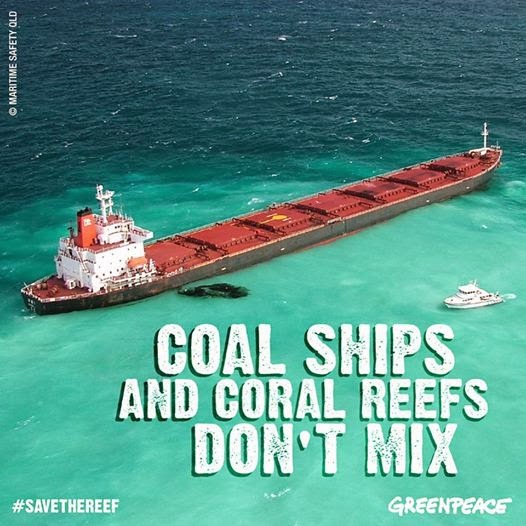In the news recently a Chinese coal ship captain was arrested for sailing through part of the Great Barrier Reef Marine Park without a pilot.
News article; http://www.abc.net.au/news/2015-02-16/chinese-coal-ship-captain-arrested-sailing-through-reef-no-pilot/6115514
Ofcourse, the usual anti coal activist organizations were quick to jump on this with their scaremongering of supposedly hundreds more coal ships going through the reef. An example below from the Greenpeace Australia Facebook page.

What, they don't bother to tell their followers , is that many ships use the waters of the Marine Park , not just coal ships. How do these people think that their goods like fuel, food and clothing get delivered to Queensland. Many cargo ships come into the country via the Great Barrier Reef bringing all sorts of goods. There are also Cruise ships going up and down the coastline on a regular basis. Fuel ships, live cattle ships, naval ships and fishing vessels to name a few.
And, as the population grows , more ships will use the waters to travel through.
Interesting Facts.
Much of the prosperity of the communities in central and north Queensland, as well as the Australian economy, is based on the mining and agriculture industry, whose products by necessity must travel through Queensland’s ports.
Access to Queensland ports requires ships to travel through environmentally sensitive areas such as the Great Barrier Reef, Torres Strait and the Coral Sea. As such, it is essential for the survival of regional communities and the Australian economy that these shipping routes remain open and available to shipping on an equitable and sustainable basis.
Commodities shipped through the Great Barrier Reef region include metal ores, coal, bauxite, liquefied natural gas, sugar, timber, oil, chemicals, live cattle and general cargo.
Source: AMSA
http://amsa.gov.au/
What the anti coal activist organizations also forget to mention is that there is a very good monitoring system in place to keep an eye on all shipping activities within the Reef waters.
REEFVTS is like air traffic control but for the waters. If it was not for this service the coal ship mentioned in the article above could very well have run aground on the reef. This is proof that the monitoring system is working well.
Ship groundings have substantially decreased since REEFVTS has been in operation,
Everyone probably remembers that in 2010 the Shen Neng 1 ran aground in an area that was not covered by the REEFVTS. After that incident the tracking area was increased to cover the whole of the Great Barrier Reef marine waters. The map below shows the area now covered by REEFVTS.
For more information about REEFVTS please check out the links below:



No comments:
Post a Comment